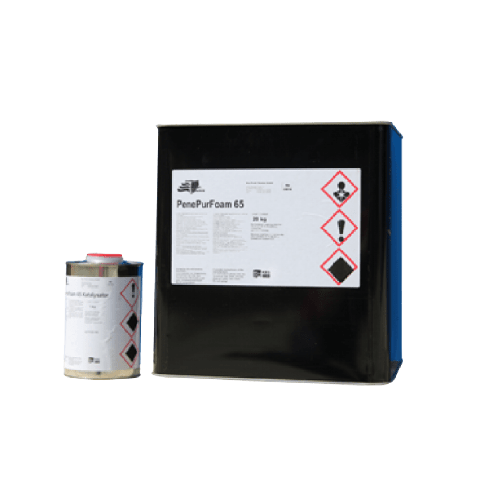
PENEPURFOM 65
Description:
One component, low viscosity, hydroactive injection polyurethane resin. When in contact with water, it foams by filling the void, forming a dense waterproof rigid foam with a closed fine mesh structure.
Destination:
- Stopping pressure leakage through building structures;
- sealing of static cracks and seams with an opening of more than 0.15 mm;
- Filling gaps in construction structures.
Advantages:
- Active reaction with water, which significantly increases the volume;
- The possibility of sealing hard-to-reach parts of constructions;
- Ability to speed up polymerization time using a catalyst. Features:
- Resistance to sea water;
- Contains no solvents and freon;
- Resin reaction products
are resistant to acids, alkalis and fungal organisms.
Technical characteristics:
|
Naming the pointer |
PenePurFom 65 |
PenePurFom 65 Catalyst |
Test methods |
|
Density, kg/m 3 |
1100 ± 50 |
950 ± 50 |
GOST 18329 |
|
Nominal viscosity* at a temperature of 20 ± 2 °С, mm2/s |
200 ± 20 |
40 ± 10 |
GOST 8420 |
|
Contact time of the resin and catalyst mixture with water and air humidity*, 20±2 °С min, should not be less |
60 (a layer is allowed to form on the surface after 3-5 minutes) |
TU 5775- |
|
|
|
|
012- |
|
|
|
|
77919831- |
|
|
During the interaction with the catalyst and water, the resin volume increases at 20±2 °С, %, no more |
6500 |
2013 |
|
* * - when the temperature decreases, the viscosity of the resin increases, and when the temperature increases, the viability of the resin decreases. Packaging.
"PenePurFom 65" - 20 kg metal container;
"PenePurFom 65 Catalyst" - 1 kg (2 pieces) metal container.
Transportation, warranty storage period.
All modes of transport are allowed.
24 months from the date of manufacture, provided that the integrity of the original packaging is not compromised. Store in a dry place at a temperature of 0 to +50°C.
INSTRUCTIONS FOR THE APPLICATION OF PENEPURFOM RESIN 65
The work should be carried out at a temperature of the surface of the structure between + 5 and + 35 ° C.
Security measures.
During work, it is necessary to use personal protective equipment: rubber gloves resistant to chemicals, cotton gloves, respirator, goggles, overalls made of dense fabric, boots. If resin comes into contact with skin or eyes, rinse immediately with water and seek medical attention.
Surface cleaning.
Using a pump or high-pressure water jet, wash the seam gap, cracks with water.
Preparation of the pump.
Use the "EK-100M" hand pump. Before using the resin, perform a test flush of the pump with hydraulic oil (eg Mob! HLP-68 or equivalent) in circulation mode.
Installation of injectors.
Usually, metal injectors with ball valves are used. The diameter of the holes should be 1-2 mm larger than the diameter of the injector (for example, if the diameter of the injector is 10 mm, the diameter of the hole should be 11-12 mm).
- Drill injection holes at an angle of ~ 45° to the surface. The distance between holes and recesses from the edge of the crack, concreting joints should be in the thickness of the structure /;
- Clean the holes from drilling debris with compressed air and install the last injector;
- Prevent the leakage of resin on vertical and upper surfaces, for this purpose make a strip of 25x25 mm along the edge of the crack and fill it with "Scrape M500 Repair" solution mixture.
Preparation. It is important!
The temperature of the resin should be at least +17 ° C. As the temperature decreases, the viscosity increases, and as the temperature increases, the life of the pot decreases.
- Select the amount of catalyst based on the water filtration rate and the ambient temperature (see table);
- prepare a control batch to evaluate the viability of the resin under the conditions of the facility;
- Prepare the amount of resin that can be used during the lifetime of the boiler: mix the resin with the catalyst for 3 minutes, by hand or with a low-speed drill (up to 300 rpm).
|
Amount of catalyst,% |
Reaction time with water depending on temperature |
||
|
+5°С |
+ 15°С |
+ 25°С |
|
|
2 |
10 min |
9 min |
6 min |
|
6 |
4 min |
3 min |
2 min |
|
10 |
2 min |
1.5 min |
1 min |
|
|
Performing injection works . It is important! Injection of resin into vertical cracks is carried out by sequential injection from bottom to top. The injection is carried out until the pressure rises or until the resin begins to flow from the next hole; Install the next injector and continue the injection process; When the viscosity of the resin increases, wash the pump with a solvent (for example, solvent 646 GOST 18188) and prepare a new part of the resin; After the main injection, before its polymerization begins, carry out an additional injection into the injectors already filled with resin; If the injectors need to be removed, fill the hole cavity with Penekrit solution mixture. Cleaning the pump. Flush the pump and hoses first with solvent (eg xylene or GOST 18188 solvent 646) and then with hydraulic oil (eg Mobil HLP-68 or equivalent). Remove the dried resin mechanically. |
